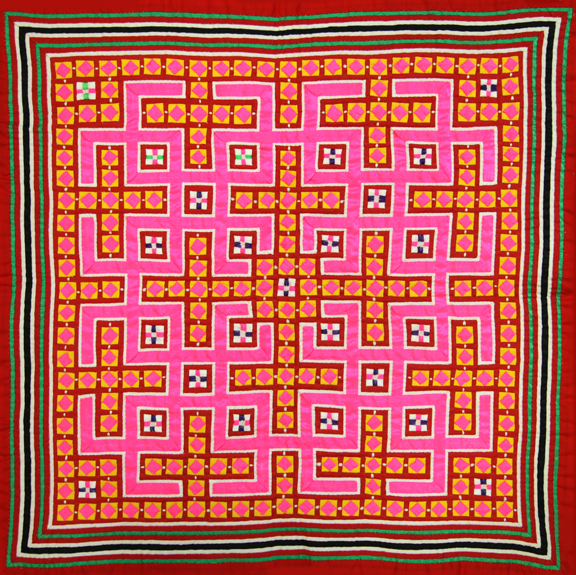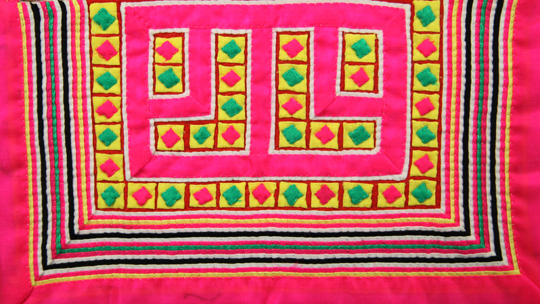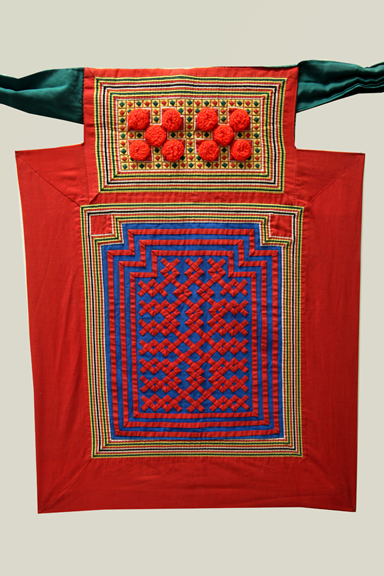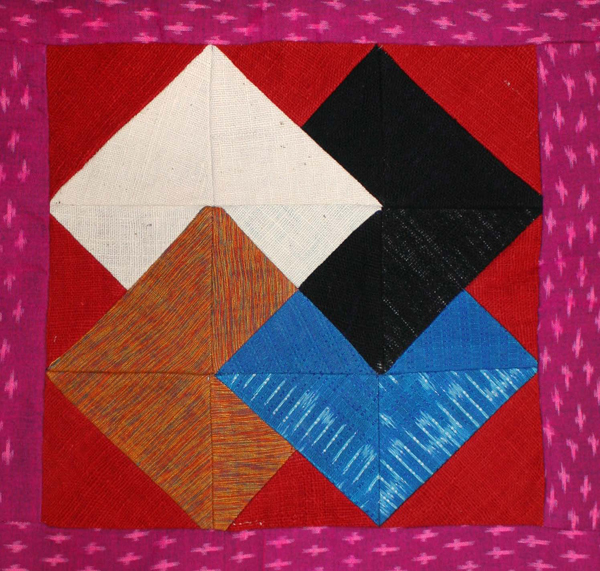Appliqué |
|---|
 |
A1: This piece uses several techniques and motifs. The modified snail motifs were sewn with white and black thread, using a chain stitch technique. The modified snail motifs have their backs against each other to create a square in the center. The white hexagons represent clams, sewn onto the red overlay cloth as appliqué. Each clam has blue threads used to create a chain for embellishments. Blue and brown borders are used as frames.
By Thia Cha, 1980s, 27x27 cm |
Back to Top |
 |
A2: This maze motif was created using a reverse appliqué technique. The reds are repeated in a counter clockwise direction, and the green border was created using the same material as the background of the piece.
|
Back to Top |
 |
A3: This tapestry was made utilizing a white monk’s cloth with embroidery in cross-stitches. Moreover, appliqué work was used to create a fence motif which was integrated into the piece. Black and white appliqué were also applied as borders or a frame.
By an unknown artist, 1980s-1990s, 39x34 cm |
Back to Top |
 |
A4: This piece is a funeral square, called a noob ncoos in the Green Hmong dialect. It is only made and used by Green Hmong, and is usually sewn by daughters or daughters-in-law for their elderly parents. The noob ncoos is placed under the head of the deceased. It is believed that the maze motif symbolizes a landscape consisting of farmland, agriculture activities, and the home the deceased will have available in the afterlife. Funeral squares are done in
By Dua Yang, 1996, 47x47 cm |
Back to Top |
A5: This is a noob ncoos square, a piece that is made to honor the deceased among the Green Hmong. The square was constructed with appliqué techniques. As is typical in some double appliqué work, there is one layer on top of another. The motif involves a landscape. It is believed among many Hmong that once the soul of the deceased is sent off to meet and live with the ancestors in the afterlife, the deceased will have land to build a house, and a farm.
By Dua Yang, 1996, 47x50 cm Photo by Xai S. Lor, item at the Hmong Archives |
Back to Top |
 |
A6: The negative spaces of this design are decorated with yellow diamond appliqué. If studied closely, they form a vertical/horizontal bar, or a cross motif. The positive space in the appliqué is red, in the motif of a square fence with overlapping extensions. Part of the design is the leaf frond motif. Inside each blue square is an ornament of pink or red diamond appliqué. This piece was meant to be the top part of a baby carrier.
By Ly Vang, before 1989, 23x29 cm |
Back to Top |
 |
A7: Done in appliqué technique, the individual components of this piece were cut, folded, and seamed with plain blanket stitches. The main motif includes a fence square with overlapping extensions at the edges. They appear to be half of a leaf frond. The work is ornamented with squares and diamond appliqué motifs. Borders and mountain motifs are ornaments which serve to make the piece complete. Designs such as this are mostly Green Hmong, found on funeral garments and baby carriers, and are referred to as old people’s designs.
By Neng Vang Yang, 1998, 22x32 cm |
Back to Top |
 |
A8: This piece of embroidery utilized the appliqué technique. It is an embroidery collar, which found on the jackets of the Green Hmong women. The techique is done similarly, and identical to the noob ncoos square.
By Ly Vang, 2007, 20x12 cm
|
Back to Top |
 |
A9: This is a baby carrier in a design that is uniquely Green Hmong. The lower panel was
By an unknown artist, 1980s-1990s, 56x42 cm |
Back to Top |
 |
A10: This unusual paj ntaub made by Hmong in Thailand is aimed toward the Western and tourist markets. It is an abstract appliqué artwork created by a method known as quilting. The cotton cloth patches, overlapping each other, are sewn onto the red background, with the purple frame as a border. The finished piece is a sofa pillowcase, sold by an organization that promotes local products and crafts in Thailand.
|
Back to Top |
Page 1 >> Page 2 |



